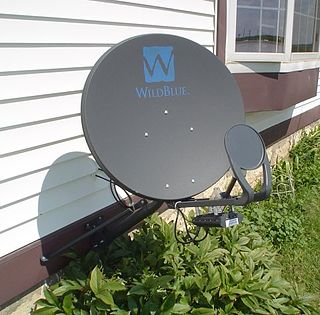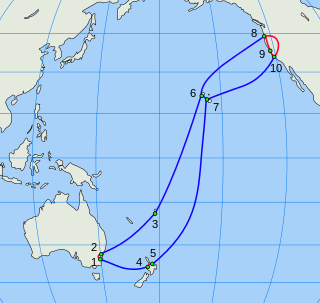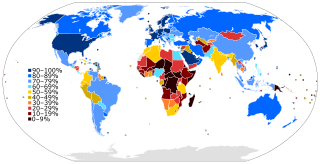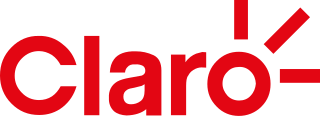Related Research Articles

Like most countries and territories in Oceania, telecommunications in the Cook Islands is limited by its isolation and low population, with only one major television broadcasting station and six radio stations. However, most residents have a main line or mobile phone. Its telecommunications are mainly provided by Telecom Cook Islands, who is currently working with O3b Networks, Ltd. for faster Internet connection.
Telecommunications in Tuvalu cover Tuvalu's 6 atolls and 3 reef islands. The islands of Tuvalu rely on satellite dishes for communication and internet access.
The telecommunication systems in Vanuatu provides voice and data services to the island nation.

Telecommunications in Australia refers to communication in Australia through electronic means, using devices such as telephone, television, radio or computer, and services such as the telephony and broadband networks. Telecommunications have always been important in Australia given the "tyranny of distance" with a dispersed population. Governments have driven telecommunication development and have a key role in its regulation.

In telecommunications, broadband or high speed is the wide-bandwidth data transmission that exploits signals at a wide spread of frequencies or several different simultaneous frequencies, and is used in fast Internet access. The transmission medium can be coaxial cable, optical fiber, wireless Internet (radio), twisted pair cable, or satellite.

Internet access is a facility or service that provides connectivity for a computer, a computer network, or other network device to the Internet, and for individuals or organizations to access or use applications such as email and the World Wide Web. Internet access is offered for sale by an international hierarchy of Internet service providers (ISPs) using various networking technologies. At the retail level, many organizations, including municipal entities, also provide cost-free access to the general public.

Satellite Internet access is Internet access provided through communication satellites; if it can sustain high speeds, it is termed satellite broadband. Modern consumer grade satellite Internet service is typically provided to individual users through geostationary satellites that can offer relatively high data speeds, with newer satellites using the Ku band to achieve downstream data speeds up to 506 Mbit/s. In addition, new satellite internet constellations are being developed in low-earth orbit to enable low-latency internet access from space.

The Southern Cross Cable is a trans-Pacific network of telecommunications cables commissioned in 2000. The network is operated by the Bermuda-registered company Southern Cross Cables Limited. The network has 28,900 km (18,000 mi) of submarine and 1,600 km (990 mi) of terrestrial fiber optic cables, all which operate in a triple-ring configuration. Initially, each cable had a bandwidth capacity of 120 gigabit/s. Southern Cross offers capacity services from 100M/STM-1 to 100 Gbit/s OTU-4, including 1G, 10G and 40G Ethernet Private Line services.

GCI Communication Corp (GCI) is a telecommunications corporation operating in Alaska. Through its own facilities and agreements with other providers, GCI provides cable television service, Internet access, wireline (networking), and cellular telephone service. It is a subsidiary of Colorado-based company Liberty Broadband, a company affiliated with Liberty Media that also owns a 26% interest in Charter Communications, having been originally acquired by Liberty in 2015.
In telecommunications, cable Internet access, shortened to cable Internet, is a form of broadband internet access which uses the same infrastructure as cable television. Like digital subscriber line and fiber to the premises services, cable Internet access provides network edge connectivity from the Internet service provider to an end user. It is integrated into the cable television infrastructure analogously to DSL which uses the existing telephone network. Cable TV networks and telecommunications networks are the two predominant forms of residential Internet access. Recently, both have seen increased competition from fiber deployments, wireless, mobile networks and satellite internet access.

Fiber to the x or fiber in the loop is a generic term for any broadband network architecture using optical fiber to provide all or part of the local loop used for last mile telecommunications. As fiber optic cables are able to carry much more data than copper cables, especially over long distances, copper telephone networks built in the 20th century are being replaced by fiber.
In data communications, the bandwidth-delay product is the product of a data link's capacity and its round-trip delay time. The result, an amount of data measured in bits, is equivalent to the maximum amount of data on the network circuit at any given time, i.e., data that has been transmitted but not yet acknowledged. The bandwidth-delay product was originally proposed as a rule of thumb for sizing router buffers in conjunction with congestion avoidance algorithm random early detection (RED).

The Internet in Africa is limited by a lower penetration rate when compared to the rest of the world. Measurable parameters such as the number of ISP subscriptions, overall number of hosts, IXP-traffic, and overall available bandwidth are indicators that Africa is far behind the "digital divide". Moreover, Africa itself exhibits an inner digital divide, with most Internet activity and infrastructure concentrated in South Africa, Morocco, Egypt as well as smaller economies like Mauritius and Seychelles. In general, only 24.4% of the African population have access to the Internet, as of 2018. Only 0.4% of the African population has a fixed-broadband subscription. The majority of internet users use it through mobile broadband.

The Internet in South Africa, one of the most technologically resourced countries on the African continent, is expanding. The internet country code top-level domain (ccTLD) .za is managed and regulated by the .za Domain Name Authority (.ZADNA) and was granted to South Africa by the Internet Corporation for Assigned Names and Numbers (ICANN) in 1990. Over 60% of Internet traffic generated on the African continent originates from South Africa. As of 2020, 41.5 million people were Internet users.
Internet access is widely available in New Zealand, with 94% of New Zealanders having access to the internet as of January 2021. It first became accessible to university students in the country in 1989. As of June 2018, there are 1,867,000 broadband connections, of which 1,524,000 are residential and 361,000 are business or government.

The Internet in the United States grew out of the ARPANET, a network sponsored by the Advanced Research Projects Agency of the U.S. Department of Defense during the 1960s. The Internet in the United States in turn provided the foundation for the worldwide Internet of today.
O3b Networks Ltd. was a network communications service provider building and operating a medium Earth orbit (MEO) satellite constellation primarily intended to provide voice and data communications to mobile operators and Internet service providers. O3b Networks became a wholly owned subsidiary of SES S.A. in 2016 and the operator name was subsequently dropped in favour of SES Networks, a division of SES. The satellites themselves, now part of the SES fleet, continue to use the O3b name.

O3b is a satellite constellation in Medium Earth orbit (MEO) owned and operated by SES, and designed to provide low-latency broadband connectivity to remote locations for mobile network operators and internet service providers, maritime, aviation, and government and defence. It is often referred to as O3b MEO to distinguish these satellites from SES's forthcoming O3b mPOWER constellation.

Broadband is a term normally considered to be synonymous with a high-speed connection to the internet. Suitability for certain applications, or technically a certain quality of service, is often assumed. For instance, low round trip delay would normally be assumed to be well under 150ms and suitable for Voice over IP, online gaming, financial trading especially arbitrage, virtual private networks and other latency-sensitive applications. This would rule out satellite Internet as inherently high-latency. In some applications, utility-grade reliability or security are often also assumed or defined as requirements. There is no single definition of broadband and official plans may refer to any or none of these criteria.

Claro Brasil is a mobile, satellite-television, fixed, and broadband telecommunications operator in Brazil. It was created in 2003 as a result of the union of six regional operators: Americel, ATL, BCP Telecomunicações, Claro Digital, & Tess Celular.
References
- ↑ "iTWire - Samoans one step closer to broadband". www.itwire.com. Retrieved 21 December 2017.
- ↑ eLandia. "eLandia and American Samoa Inaugurate Submarine Cable" . Retrieved 21 December 2017.
- ↑ "Hawaiki Cable Network" . Retrieved 26 July 2018.
- ↑ "Samoa News - Hawaiki cable now live, promising faster, more reliable internet service" . Retrieved 26 July 2018.
- ↑ "Hawaiki Transpacific Cable Completes Final Landing at American Samoa" (PDF). Retrieved 26 July 2018.
- ↑ "The most expensive internet in America: fighting to bring affordable broadband to American Samoa". Engadget. 2012. Retrieved October 8, 2018.
- ↑ "AMERICAN SAMOA FIBER OPTIC NETWORK". Underground Construction. Oildom Publishing Company of Texas, Inc. December 2015. Archived from the original on 2016-12-22. Retrieved 2016-12-22.
- ↑ "American Samoa Telecommunications Authority (ASTCA) Goes Live with O3b Networks, Significantly Improves Broadband-based Services to Territory Residents". O3b Networks. 2015-06-15. Archived from the original on 2016-12-22. Retrieved 2016-12-22.
{{cite web}}: CS1 maint: bot: original URL status unknown (link) - ↑ "Internet - ASTCA". 10 November 2015. Archived from the original on 10 November 2015. Retrieved 21 December 2017.
{{cite web}}: CS1 maint: bot: original URL status unknown (link) - ↑ "Economic Development plan revives hope for call center". Osini Faleatasi Inc. 2015-02-15. Retrieved 2016-12-22.
- ↑ ASTCA - Samoatelco , BlueSky Communications , Pacifica IT Archived 2007-08-22 at the Wayback Machine
- ↑ Miller, Monica (August 2017). "American Samoa Telecommunications Authority". RNZ. Retrieved 15 September 2020.
- ↑ http://www.sraa.co.nz/Projects/Commercial/ASTCA+Telecommunications+Building.html "ASTCA Telecommunications building - Swan Railley Architects". Retrieved September 4, 2019.